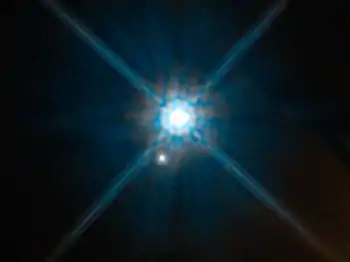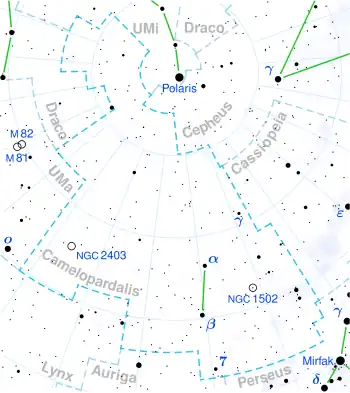Stein 2051
Stein 2051 (Gliese 169.1, G 175-034, LHS 26/27) is a nearby binary star system, containing a red dwarf (component A) and a degenerate star (white dwarf) (component B), located in constellation Camelopardalis at about 18 ly from Earth.[12]
 Image of Stein 2051 B and a background star taken by the Hubble Space Telescope.[1] Credit: NASA, ESA, and K. Sahu (STScI) | |
| Observation data Epoch J2000 Equinox J2000 | |
|---|---|
| Constellation | Camelopardalis |
| Stein 2051 A | |
| Right ascension | 04h 31m 11.5181s[2] |
| Declination | +58° 58′ 37.461″[2] |
| Apparent magnitude (V) | 10.977[2] |
| Stein 2051 B | |
| Right ascension | 04h 31m 12.570s[3] |
| Declination | +58° 58′ 41.15″[3] |
| Apparent magnitude (V) | 11.19[3] |
| Characteristics | |
| Stein 2051 A | |
| Spectral type | M4.0Ve[2] |
| U−B color index | +1.21[4] |
| B−V color index | +1.65[4] |
| Stein 2051 B | |
| Spectral type | DC5[3] |
| U−B color index | -0.53[4] |
| B−V color index | +0.31[4] |
| Astrometry | |
| Stein 2051 A | |
| Radial velocity (Rv) | 29 km/s |
| Proper motion (μ) | RA: 1300.365 mas/yr[5] Dec.: -2046.106 mas/yr[5] |
| Parallax (π) | 181.2438 ± 0.0499 mas[5] |
| Distance | 17.995 ± 0.005 ly (5.517 ± 0.002 pc) |
| Stein 2051 B | |
| Radial velocity (Rv) | 2.0 km/s |
| Proper motion (μ) | RA: 1334.780±0.021[6] mas/yr Dec.: −1947.638±0.019[6] mas/yr |
| Parallax (π) | 181.2730 ± 0.0203 mas[6] |
| Distance | 17.993 ± 0.002 ly (5.5165 ± 0.0006 pc) |
| Details[7] | |
| Stein 2051 A | |
| Mass | 0.252±0.013[8] M☉ |
| Radius | 0.292±0.031[8] R☉ |
| Luminosity | 0.0081[8] L☉ |
| Surface gravity (log g) | 4.80+0.13 −0.10 cgs |
| Temperature | 3277+42 −75 K |
| Metallicity [Fe/H] | 0.26+0.06 −0.22 dex |
| Rotational velocity (v sin i) | 5.2+1.7 −2.7 km/s |
| Stein 2051 B | |
| Mass | 0.675±0.051[9] M☉ |
| Radius | 0.0114±0.0004[9] R☉ |
| Temperature | 7122±181[9] K |
| Other designations | |
| Stein 2051 A: LHS 26, NLTT 13373, TYC 3744-412-1, 2MASS J04311147+585837, WISE J043113.20+585816.7[2] | |
| Stein 2051 B: EGGR 180, LHS 27, NLTT 13375, TYC 3744-2062-1, 2MASS J04311201+5858476, WD 0426+58, WD2 0426+585, WD3 0426+588[3] | |
| Database references | |
| SIMBAD | The system |
| A | |
| B | |
 Stein 2051 Location of Stein 2051 in the constellation Camelopardalis | |
Stein 2051 is the nearest (red dwarf + white dwarf) separate binary system (40 Eridani BC is located closer at 16.26 light-years,[13] but it is a part of a triple star system).
Stein 2051 B is the 6th nearest white dwarf after Sirius B, Procyon B, van Maanen's star, LP 145-141 and 40 Eridani B.
Properties
The brighter of this two stars is A (a red dwarf), but the more massive is component B (a white dwarf).
In 2017, Stein 2051 B was observed passing in front of a more distant star. The bending of starlight by the gravitational field of the nearer star allowed its mass to be directly measured. The estimated mass of Stein 2051 B is 0.675±0.051 M☉, which fits the expected range of a white dwarf with a carbon-oxygen core.[9]
References
- "Einstein revisited". www.spacetelescope.org. Retrieved 12 June 2017.
- "NAME Stein 2051 A". SIMBAD. Centre de données astronomiques de Strasbourg. Retrieved 26 December 2016.
- "NAME Stein 2051 B". SIMBAD. Centre de données astronomiques de Strasbourg. Retrieved 20 December 2016.
- Hardie, R. H. (1966). "UBV Photometry of the Lowell Proper Motion Object G175-34". Publications of the Astronomical Society of the Pacific. 78 (462): 171. Bibcode:1966PASP...78..171H. doi:10.1086/128321.
- Brown, A. G. A.; et al. (Gaia collaboration) (2021). "Gaia Early Data Release 3: Summary of the contents and survey properties". Astronomy & Astrophysics. 649: A1. arXiv:2012.01533. Bibcode:2021A&A...649A...1G. doi:10.1051/0004-6361/202039657. S2CID 227254300. (Erratum: doi:10.1051/0004-6361/202039657e). Gaia EDR3 record for this source at VizieR.
- Brown, A. G. A.; et al. (Gaia collaboration) (2021). "Gaia Early Data Release 3: Summary of the contents and survey properties". Astronomy & Astrophysics. 649: A1. arXiv:2012.01533. Bibcode:2021A&A...649A...1G. doi:10.1051/0004-6361/202039657. S2CID 227254300. (Erratum: doi:10.1051/0004-6361/202039657e). Gaia EDR3 record for this source at VizieR.
- Passegger, V. M.; Bello-García, A.; Ordieres-Meré, J.; Caballero, J. A.; Schweitzer, A.; González-Marcos, A.; Ribas, I.; Reiners, A.; Quirrenbach, A.; Amado, P. J.; Azzaro, M.; Bauer, F. F.; Béjar, V. J. S.; Cortés-Contreras, M.; Dreizler, S.; Hatzes, A. P.; Henning, Th.; Jeffers, S. V.; Kaminski, A.; Kürster, M.; Lafarga, M.; Marfil, E.; Montes, D.; Morales, J. C.; Nagel, E.; Sarro, L. M.; Solano, E.; Tabernero, H. M.; Zechmeister, M. (2020), "The CARMENES search for exoplanets around M dwarfs", Astronomy & Astrophysics, 642: A22, arXiv:2008.01186, doi:10.1051/0004-6361/202038787
- Ghosh, Samrat; Ghosh, Supriyo; Das, Ramkrishna; Mondal, Soumen; Khata, Dhrimadri (2020), "Understanding the physical properties of young M dwarfs: NIR spectroscopic studies", Monthly Notices of the Royal Astronomical Society, 493 (3): 4533–4550, arXiv:2002.05762, doi:10.1093/mnras/staa427
- Sahu, Kailash C.; et al. (June 2017), "Relativistic deflection of background starlight measures the mass of a nearby white dwarf star", Science, 356 (6342): 1046–1050, arXiv:1706.02037, Bibcode:2017Sci...356.1046S, doi:10.1126/science.aal2879, PMID 28592430, S2CID 206654918.
- Perryman; et al. (1997). "HIP 21088". The Hipparcos and Tycho Catalogues. Retrieved 2014-11-23.
- Gliese, W. & Jahreiß, H. (1991). "Gl 169.1". Preliminary Version of the Third Catalogue of Nearby Stars. Retrieved 2014-11-23.
- Van Altena W. F.; Lee J. T.; Hoffleit E. D. (1995). "GCTP 986.01". The General Catalogue of Trigonometric Stellar Parallaxes (Fourth ed.). Retrieved 2014-11-23.
- Perryman; et al. (1997). "HIP 19849". The Hipparcos and Tycho Catalogues. Retrieved 2014-11-21.
External links
- "CCDM J04312+5858AB -- Double or multiple star". Centre de Données astronomiques de Strasbourg. Retrieved 2012-01-02. (the whole system)
- "NAME STEIN 2051A -- Star in double system". Centre de Données astronomiques de Strasbourg. Retrieved 2012-01-02. (component A)
- "GJ 169.1 B -- Star in double system". Centre de Données astronomiques de Strasbourg. Retrieved 2012-01-02. (component B)